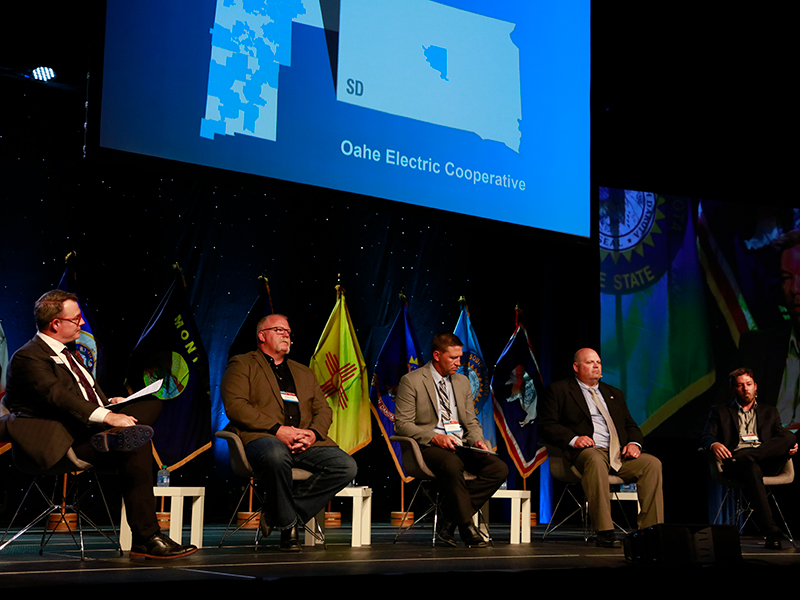Below is a summary of the Investing for the Future Panel at the 2024 Basin Electric Annual Meeting.
Moderator:
- Andy Buntrock, vice president of Strategic Planning and Communications
Panelists:
- Becky Kern, vice president of Resource Planning and Rates
- Matt Ehrman, vice president of Engineering and Construction
- Katrina Wald, vice president and controller
- Sarah Scherm, vice president and treasurer
The discussion began with panelists sharing their involvement with the annual load forecast. Becky Kern’s group processes the load forecast, Matt Ehrman’s group works on the long-range engineering plan, and Katrina Wald’s group takes all that into account and adds in the expenses.
“We include assumptions associated with the load forecast and the long-range engineering plan in our financial forecast, along with a lot of other assumptions. We're making assumptions in regard to commodity prices, interest rates, and what our debt issuances are going to be to finance those investments. We're also looking at estimates for surplus sales,” Wald said.
Next, Andy Buntrock asked Kern about changes to the member load within the financial forecast.
Kern said we are seeing substantial changes in our member load obligations.
“Over the last two years or so, we've seen around 7% growth on our annual member sales, so we're seeing substantial increases in our member load obligations,” Kern said.
She said the first 10 years of the load forecast are showing around 3% annual load growth. Kern said a major driver of this is larger loads, such as crypto, hydrogen, ammonia, carbon capture, agriculture, and oil and gas development.
Wald discussed the significant investment Basin Electric will need to make to fulfill the membership’s increasing load.
“I think we've heard a couple times this morning that over the next ten years, we're estimating our capital expenditures to be around $8 billion. That's right, I said $8 billion. That's quite a significant amount of money, and 80 percent of that is in new generation and transmission. However, we also have about $1 billion that we're projected to spend on our existing facilities,” Wald said.
Sarah Scherm talked about the different sources of financing that the cooperative has access to, including the membership.
“Oftentimes we don't always think of the membership as financers, but when we set our margin each year and collect margin from the membership, they're funding roughly 25% of our capital projects through that margin, so they really are our largest single source of funding at any given time,” Scherm said.
Scherm also touched on going out in the capital market for funding.
“When we look at the financial forecast, we're seeing that over the next ten years we'll issue about $5 billion of additional debt, with about $3 billion of that coming in the next five years. For a little context, our current debt balance is under $5 billion, so we're talking about essentially doubling it in the next decade,” Scherm said.
Next, Buntrock asked Ehrman about the effects of inflation on construction costs. He said on top of inflation and supply chain issues, there’s a lot of competition for materials.
“We're developing a lot of projects, there's a lot of others also developing projects. Everyone's really trying to get their hands on the same pieces of equipment all kind of at once, it seems like, and as a result of that, oftentimes the raw materials and the factories just aren't able to keep up with demand,” Ehrman said.
The conversation continued with Scherm talking about the effects of rising interest rates and Wald discussing safeguards put in place to protect members.
The discussion shifted to projects where construction has already begun. Ehrman gave an update on Pioneer Generation Station Phase 4, Roundup-to-Kummer Ridge, and various substations. He also talked about other projects that have been planned but are not yet underway, like a natural gas-fired resource with a preferred site in northwest North Dakota.
Ehrman also said the Basin Electric board of directors approved the repowering of one of the cooperative’s wind facilities, so his team is moving full steam ahead on that project. He then gave an in-depth update on the East Loop project, a 345-kilovolt transmission line.
Next, Scherm talked about the potential benefits of becoming a Security Exchange Commission registrant.
“This really builds on the last conversation about us running into limits within the private placement market in particular. With the amount of capital we need to raise going forward, we really need to find new sources of financing,” Scherm said.
Kern provided an update on Basin Electric’s power purchase agreements.
“We have recently moved forward with a new tolling arrangement in MISO to start in the next couple of years. That will get us some dispatchable energy going forward and some capacity. We are also working on acquiring some point-to-point transmission service that will help connect our system down in Wyoming up into Montana,” Kern said.
Scherm gave a high-level overview of the Inflation Reduction Act and how it can help lower the cost of construction.
Ehrman then discussed the updates being done at Basin Electric’s existing facilities so they continue operating safely, reliably, efficiently, and environmentally responsibly.
The conversation wrapped up with Ehrman talking about the Basin Electric Horizons Team and their role in evaluating opportunities to help determine the feasibility and application of different technologies.

